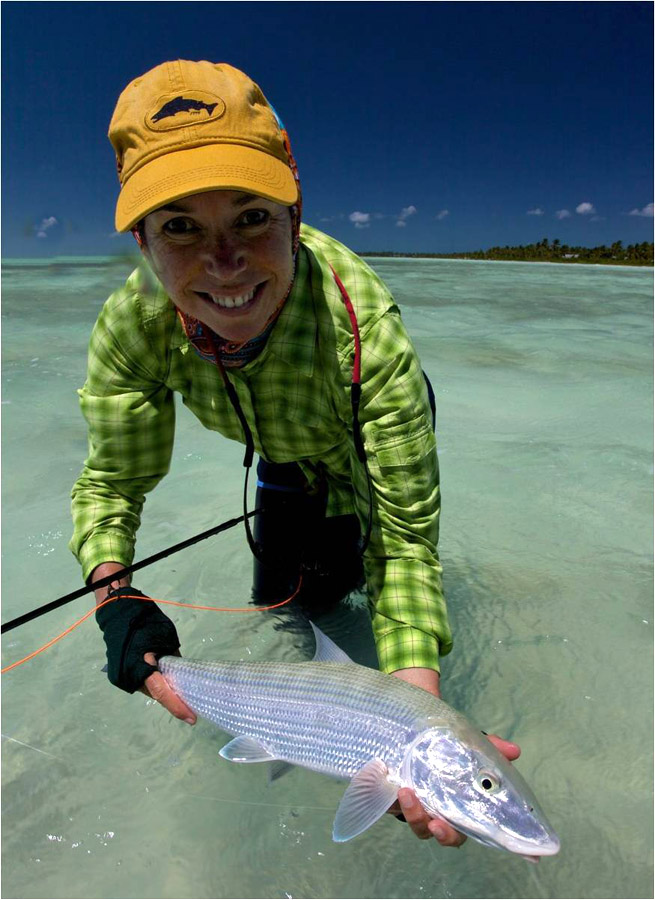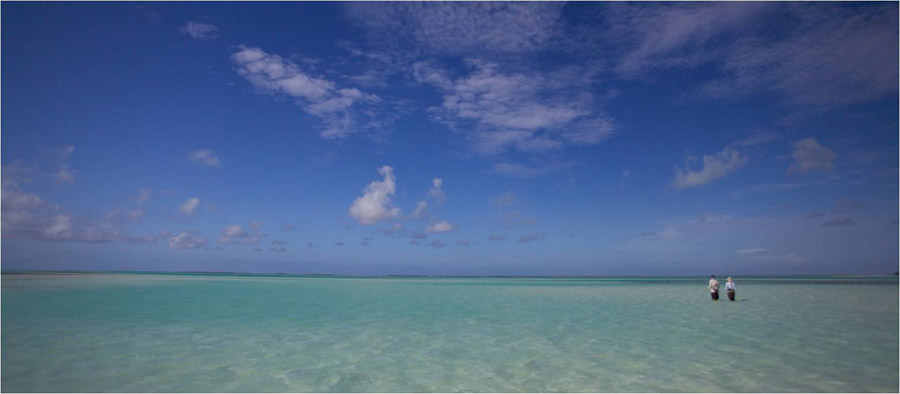After years of wanting to catch a bonefish, last winter, in the middle of a freezing Canberra winter, I cracked, and organised a trip for this year. After talking to quite a few people, I decided on Christmas Island as the destination. The bonefishing was wonderful, but our group also caught Triggerfish, big Giant Trevally, Bluefin Trevally, Golden Trevally, Queenfish, Yellow and Red Snapper, Grouper, Swallowtail Dart, Ladyfish, Sweetlip, Coral Trout, Puffer Fish, Sharks, and quite a few other species too, so it’s an incredibility diverse fishery.
I did fish mostly with graphite (a discontinued Winston BL5, which is the nicest #7 graphite I’ve ever cast), but I took four bamboo rods with me to share around the group for some field testing. The bamboos all performed pretty well, but I’m still undecided about cane in the salt. Unlike stream fishing for trout, where I believe bamboo is unsurpassed in performance, in the salt, at the limits of casting range in strong wind, I think graphite might be here to stay! I do want to do some more development on flats style bamboo rods in the #6-8 range, as it feels like unfinished business. I guess I need to make bonefishing a regular event! And all the bamboo rods came through the 2 weeks in good shape, while around 10 graphites were broken. Ha ha.
We went for two weeks, so we had the chance to have a few days off fishing to experience the local culture too, which really let us unwind and slow down to “island time”. I’ve been on trips before where you feel the time running out from day one, and by fishing hard every day you miss out on the culture and holiday aspect of travel, so I was pleased for the extra week. As it was, time really flew by.
The weather was surprisingly pleasant. It was nothing like the heat of the tropical North of Australia, and though we were allocated 3 bottles of water per day on the flats, I often only got through one or two. In Weipa I’ve guzzled half a dozen litres of cold water and still needed more. The air and the water were about the same temperature - around 26-28 degrees - it was truly idyllic. We did have pretty strong winds most days, and I think this helped with the comfort levels, without adversely affecting the fishing. I would say that to get the most out of your trip, it’s worth doing some practise down at the park on windy days, with a weighted practise fly and focusing on fast, accurate, delicate presentations out to around 40 feet, rather than throwing as far as you can.
Click in images to enlarge

Right on the water
We stayed at “The Villages”, right on the water. The boats that took us to the flats were less than a hundred metres from the doorsteps of our bungalows. Each morning it was just a matter of waking up to a comfortable 24 degrees, having breakfast, grabbing your fishing bag and walking to the boats (the guides load your rods onto the boats from the rod racks outside your bungalow). It was certainly easier to get up there with these sunrises, warm weather and prospect of flats fishing, compared to 5 below freezing in a Canberra Winter!

The locals were really friendly. It was lovely to be greeted by smiles and waves, wherever we went.

Full moon over the lagoon.
Of course, bonefish are what brought us there, and they didn’t disappoint. We had a lot of sight casting opportunities to fish of all sizes, while wading in shallow water. Most fish are in the 1-3lb range, with a sprinkling of larger fish. We caught fish up to around 5 lb, but others in the group reported fish of 7 lb and higher.

Miri Taransky with a decent bonefish
There are a huge variety and number of flats inside the lagoon. Fishing was usually in ankle deep to knee deep water, sight fishing to bonefish and other species. A guide per angler is available at the Villages. You could fish without another angler in sight, or if you wanted, fish a flat with a friend to take photos and share the experience. The option was available to share a guide if you wanted to stick really close by. The guides were all fantastic. Their ability to see fish was uncanny, and it took a few days to learn how to see the fish. It’s quite different to spotting trout. Coming at you, they can be quite visible as a blue shape (reflecting the sky?), but side on, they can literally disappear before your eyes, as their chrome sides mirror the bottom perfectly.

Even in shallow water like this, the fish can be virtually invisible. The guide here is the Villages head guide, Neemia, who came to Tasmania and fished the Commonwealth Fly Fishing Championships in 2012. Most presentations and takes were close range - as little as 5 feet from the rod tip - out to 40 feet or so. The emphasis was on getting the fly out there quickly and gently as possible, taking into account a range of eye weights on the flies (the depth of water and strength of tide flow dictated the fly weight - bones generally don’t like the fly far off the bottom). Crazy Charlie type flies, sparsely dressed in sizes 4-8 were popular with the guides, though some looked through both my fly boxes and asked if I had another box! Nial Logan (the Australian booking agent for “The Villages”) gave us a range of fly recipes in recommended colours as part of the pre trip briefing notes which were very helpful.

Triggerfish were another fantastic sight fishing target on the flats. They tail around the coral patches, with their tail and fins making them much, MUCH easier to see than bonefish. Catching them is a real challenge though. They spook if the fly lands too close or they see it dropping, frequently bite off (or through) the hook, and run at least as hard as the bones. They also dive into holes in the coral, shredding the leader.

Triggerfish
There was much more to the trip than the fishing. We met two doctors - Larry, from the USA, and Ilsa, from Cuba, volunteer working at the local hospital. It was very moving to see these talented, hardworking people contributing to the very basic medical services available and literally saving lives on a daily basis. As you can see, Larry is a keen fly angler, so when he had some time off, he made straight for the water! Ilsa is in the background, getting her first fly fishing lesson from Neemia, where she managed to catch a bonefish. She said it pulled very hard!

Ilsa is in the background, getting her first fly fishing lesson from Neemia

Ilsa with Miri, on the Ocean side of the island.
Larry is an adventurous guy at 67 years of age. He donned a snorkel and fins here and leapt into the surf over the sharp reef. At one point I thought “at least we have one doctor left”! Well, he obviously made it out alive… Here he is, later in the trip, giving us a tour of the Hospital in “London”. (The island was a base for British Nuclear testing in the 1950’s, and a lot of the place names are taken from Europe - London, Paris, and Poland, to name a few).

Larry (lcentre) at his hospitall talking to the author
Wildlife abounds on the island, including many species of birds and crabs. Hermit crabs were a favourite.


Mantis shrimps live in holes in the flats, and can be caught by the guides, a little like catching beach worms, using bait to entice them to the top of their hole.

The claws (like a giant praying mantis) are incredibly sharp and fast, so it’s a task best left to the guides, but still fascinating to watch. And they taste better than crayfish. We took pity on this fellow and let him go again though.
Kiribati Independence day was celebrated during our visit. We took a day off fishing to look at the activities. Kids from the island marched and performed in their colourful school uniforms or costumes like these. It was well worth a morning off fishing to see this!

The Independence Day activities featured a game of Oreano - the national game of Kiribati. Think of volleyball, but played with a bowling ball, and no net! The ball is made mostly of a particular heavy ocean stone, wrapped in coconut fibre and/or other string. It weighs about 5kg!

The server sprints as fast as they can before launching the ball from a set position (marked by the log in the photo below), with additional speed coming from rolling/pushing it off the arm. As they explained to me, trying to strike it from a stationary position would break your arm. The receiving team then tries to catch the ball (which can still break your arm or ribs). If they fail to catch it, the serving team wins a point. If they do catch it, they get to serve the ball back. Ouch!
Maybe it was the friendliness of the people and their culture that was best of all. All the people at the Villages did everything to make our stay enjoyable and comfortable. On the last morning we were presented with some lovely pillow cases by one of our guides, Hansen, hand embroidered by his wife. It was an unexpected and very moving gift.

Suffice to say that it was a wonderful trip and I’m planning a return visit already. When I returned home to -7 Celsius in Canberra it was tempting to get straight back on the plane!
(Villages Kiribati website: http://kiribatitourism.gov.ki/index.php/accommodation-55/accommodationonkiritimatiisland/34-accommodation/accommodationkiritimati/64-thevillage Note: Nick is a world class bamboo rod maker. His business is based in the Blue Ribbon Trout fishing Monaro region of NSW in Australia. The diverse waters and selective trout of the Snowy-Monaro region provide an unrivalled environment for testing and developing fly rod actions and construction for Australian conditions. The low humidity inland climate is also ideal for bamboo rodmaking.
Nick uses traditional methods and the best materials available today to make his rods. I strongly advise you to visit his website at http://www.taranskybamboo.com.au . He also deals in Peerless traditional fly reels, silk lines and many other fly fishing related products.
Tom Sutcliffe )



